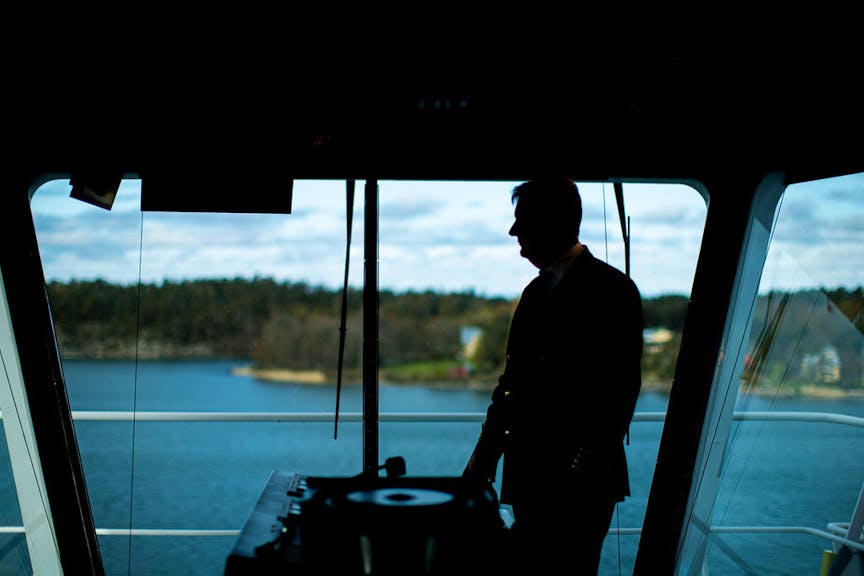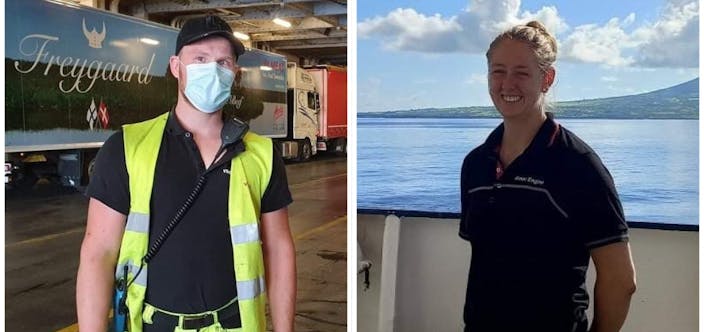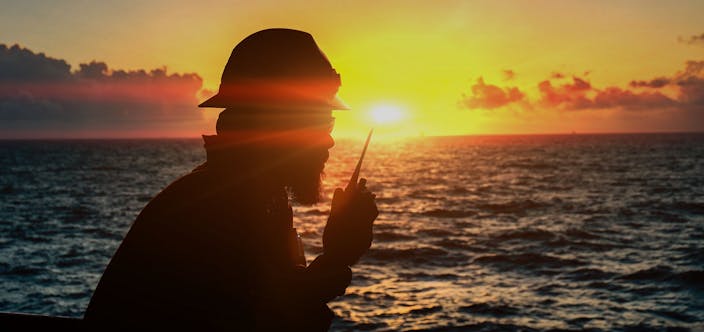Trauma in Shipping: Next steps
Alandia and Seaways Psychology Services have been working together on a project addressing trauma in shipping, where we have explored a range of industry and clinical perspectives on this important topic.

Our Trauma Survey, Trauma in Shipping workshop, and our Next Steps webinar raised many crucial points of discussion and provoked some excellent questions from our attendees. With time constraints being necessary for these online events, inevitably the panel were not able to answer every question received. However, we fully value each of these questions and therefore have asked our esteemed panellists to kindly write their answers.
Trauma in shipping: Next Steps webinar
Q&A with panel in the Trauma in Shipping: Next Steps webinar
1. As Chaplains we are often not allowed to meet with crew after a trauma incident. The shipping companies will fly the crew home, or the ship will sail away. We will sometimes meet crew who are struggling but as the panel will be aware any type of assistance or help sometimes takes more than a couple of minutes over a cup of coffee. I would suggest that shipping companies will need to take responsibility for more detailed debriefing and follow up care after trauma incidents
“I fully agree and company procedures for post-incident management should include the provision of follow-up care and importantly informing the seafarer of the mechanisms to receive it and normalise/de-stigmatise such follow-up support.”
– Ann Till
“From an investigation or legal perspective, there can be reasons why crew are repatriated, removed from the vessel, or given limited access to external parties. This of course depends on the nature of the incident and, in my view, should not detract from the involved personnel receiving appropriate support where necessary. I believe that they should be seen as a valued resource and personnel should be afforded post-incident support through structured systems and increased awareness. Increasing awareness of wellbeing and how trauma could manifest in the individual also seems very beneficial to me.”
– Chris Gascoigne
“Absolutely, we would encourage companies to include an element of post incident support planning into their emergency response protocols. Where appropriate policies and procedures have not been established it’s important that Chaplains, as well as company staff and investigators, or anyone who becomes aware of seafarers who may be struggling, are able to share information and signpost seafarers for further support where they might need it. From a clinical perspective, ‘debriefing’ refers to a particular approach that was popular in the past and it has since been shown that it can potentially be harmful for some people and so it is not recommended. When considering critical incident response processes and procedures it is very important that policies and procedures are guided by Clinical Psychologists or other Mental Health Professionals with specialist expertise in evidence-based trauma response. “
– Dr. Pennie Blackburn
“I have experience, from different companies, both good and less desired trauma management. The management that I consider good, also in hindsight with all the trauma knowledge I have today, is support to the master and crew before the vessel arrives to port. Sometimes it can be weeks before vessel is alongside, therefore important that the master and crew are supported and the master is provided with tools and information how to best manage the situation and where the helplines are when crew want/need to talk “outside” of the vessel. When alongside the crew should be met by professionals, in my cases it was often specialist psychologist with crisis, chaplain, and HR personnel. These would stay with the crew until repatriation (a day or two) and the follow up counselling/meetings were arranged after repatriation. Overall, the costs were moderate and all of the crew members came back to service. “
– Captain Martti Simojoki
2. Bullying and discrimination at sea affects mental health and wellbeing. This is more of a long-term psychological impact but it’s an impact. How can seafarers move on from trauma and toxic experiences and turn them into something worthwhile?
” I would suggest this could be an excellent topic for another webinar! From my experience, I have taken some of my experiences and turned them both into something worthwhile but also healing for myself in raising awareness and supporting others who have experienced similar events including on a one-to-one personal level as well as volunteering with Safer Waves. “
– Ann Till
“Bullying and discrimination is, of course, not solely a problem at sea.
One key difference at sea is that the bullied/discriminated individual could be a position where they simply have no access to a friendly face, due to that life at sea and, say, a small crew size. I would say that as well as the obvious impacts on that individual, such as depression, anxiety and disengagement, their decision making can be adversely influenced, either directly or indirectly, by the bullying or discrimination.
It can be the case that consequential poor decision making or feeling forced to make a decision known by the individual to be risky or wrong, can lead to incidents, which then become subject to investigation. As we have discussed online, the trauma experienced as a result of that subsequent incident is then compounded in the individual, with feelings of guilt, inadequacy and regret over the fact that they feel they let themselves be bullied. All of this can lead to long term mental health issues with the individual, which are often not dealt with.
Many shipping companies have clear anti-bullying and non-discrimination policies, so these matters are well known in the industry. What I believe is less well known and not necessarily addressed, are the potential consequences of bullying and discrimination, beyond the obvious.
I strongly believe that given the tools and support, it is possible to turn bad experiences into positives, including being able to support colleagues and others who may face the same issues.”
– Chris Gascoigne
“Bullying and harassment can be very difficult to cope with and often causes significant distress. All companies should have a zero-tolerance policy towards bullying and harassment and processes in place to prevent, investigate and manage complaints quickly and effectively which assure the complainant of fair treatment and protection against any negative consequences of raising concerns. People subjected to Bullying or harassment of any nature will benefit from some confidential support from a third party to help them determine the best course of action for themselves.
Often people do learn from adversity or negative experiences in life; be they traumatic experiences, periods of life stress or even being on the receiving end of bullying or harassment and sometimes can emerge with new perspectives, ways of coping, more compassion, or other consequences of value. We even have a term in psychology called ‘post traumatic growth’ which acknowledges this can be the case even after serious traumatic events.”
– Dr. Pennie Blackburn
“Onboard a vessel, especially if the bullying/discrimination is coming from higher/highest ranks, very difficult for the “bullied” to effectively do anything to change the situation. This is why each company should have a well functioning and effective whistle blowing system, which perceived and rewarded as positive thing. Whistle blowing as a term has a negative connotation, which it is by its intention and nature not at all. Once the situation is resolved it is equally important to have a professional debriefing where the issues are discussed and dealt with (to the extent it helps to clear the situation and it is for the benefit of the ones bullied/harassed). In the industry we still have too many cases (more than 0) of bullying/harassment and more awareness of the zero tolerance is needed. It is not something that is funny and someone is supposed to endure – quite the contrary. “
– Captain Martti Simojoki
3. Are there any other industries that are setting a good example that we can learn from?
“In so far as trauma is concerned, the military and emergency responders (such as the fire service, police, CSI, and medics) would seem likely to be a good starting reference in answering this question. Clearly, the average seafarer is unlikely to experience the same risk of trauma as a front-line soldier or medic, but the principals of recognising and treating trauma would be similar.“
– Chris Gascoigne
“Sectors where exposure to critical incidents are recognised as part of the role like the emergency services, humanitarian and disaster response services, and the military have been raising awareness and developing services for some time now. There is a lot that can be learned from other sectors. The psychological evidence regarding effective response following critical incidents base is well established but the specifics of policies and procedures and how to implement support services within the shipping industry creates unique challenges which will require experts from within the industry and experts in psychological responses to work collaboratively. “
– Dr. Pennie Blackburn
“If the questions is about psychological trauma then there are professions/industries which have come further than the maritime. Police force, military, paramedics, and social services have procedures, best practices and heightened awareness of trauma and its management. “
– Captain Martti Simojoki
4. Chris: Can you identify any areas of the investigation process that could be changed to lessen the traumatic effect of the enquiry itself following a critical event?
“I believe that investigations can be successfully carried out with empathy and understanding, this can help the individuals involved.
From an investigation perspective, it is typically the aim to identify the cause of incident. Ultimately that cause will more often or not have a person or persons behind it.
Clearly, incidents vary but an increased awareness of how an individual could react to essentially being blamed, or feeling responsible, for an incident is, I believe, often not recognised. There are always elements in society who may seek to cause problems, but the majority of people do not. Most seafarers do not go to sea wanting to cause incidents or experience trauma.
Giving additional thought to why an individual made a decision leading to an incident, and where necessary supporting them thereafter, rather than simply terminating their employment and discarding them, could carry great benefit to those involved, and other stakeholders in the industry. If the cause of a bad decision is identified, it can hopefully be mitigated in the future to prevent recurrence.
An individual who has been through that entire process and recognises what went wrong and is assisted with dealing with it, can add positively to the industry, possibly more so than someone has not been involved in such events.”
– Chris Gascoigne
5. Pennie: How can we better assess the mental state of a seafarer after a critical event? Rather than just asking them if they are okay and then continuing normal operations, should there be some sort of formal assessment to identify whether there are any signs of trauma present, such as PTSD. (I am aware that in some industries, after a critical event the individuals involved are mentally assessed and cleared by a medical official as a standard procedure before they are sent back to work.)
“We would encourage companies to look at the response as a whole and to seek specialist advice about how to implement critical incident response mechanisms to ensure seafarers and anyone affected by the incident (families, shoreside staff other others) can access support they might need. There are a number of different approaches which can be employed here, but just asking if everyone is ok is not sufficient. It is important to know that most people will recover effectively after a critical incident, this can be facilitated by good response mechanisms, but lack of response or poor responses can be harmful. There are brief assessment tools which can be used but I would recommend that they would be part of a coherent response, which is likely to include some information about what to expect following trauma, positive coping strategies, and how to access further support.“
– Dr. Pennie Blackburn
6. Ann: When it comes to educating Cadets to prepare them for some of the challenges that they could find themselves facing at sea (and which could cause mental trauma), do you think that it risks discouraging the younger generation from a career at sea? Does it make the career less desirable?
“The same could be said for many careers where there is an elevated risk of some form of assault or trauma. For example, first line emergency services. I would say that it is better to prepare and inform potential recruits (who are not always a younger generation, as some Cadets embark on the career in their 30’s or even 40’s), and have people enter the industry appropriately informed (without scare-mongering).”
– Ann Till
 “I fully agree and company procedures for post-incident management should include the provision of follow-up care and importantly informing the seafarer of the mechanisms to receive it and normalise/de-stigmatise such follow-up support.”
“I fully agree and company procedures for post-incident management should include the provision of follow-up care and importantly informing the seafarer of the mechanisms to receive it and normalise/de-stigmatise such follow-up support.” “From an investigation or legal perspective, there can be reasons why crew are repatriated, removed from the vessel, or given limited access to external parties. This of course depends on the nature of the incident and, in my view, should not detract from the involved personnel receiving appropriate support where necessary. I believe that they should be seen as a valued resource and personnel should be afforded post-incident support through structured systems and increased awareness. Increasing awareness of wellbeing and how trauma could manifest in the individual also seems very beneficial to me.”
“From an investigation or legal perspective, there can be reasons why crew are repatriated, removed from the vessel, or given limited access to external parties. This of course depends on the nature of the incident and, in my view, should not detract from the involved personnel receiving appropriate support where necessary. I believe that they should be seen as a valued resource and personnel should be afforded post-incident support through structured systems and increased awareness. Increasing awareness of wellbeing and how trauma could manifest in the individual also seems very beneficial to me.” “Absolutely, we would encourage companies to include an element of post incident support planning into their emergency response protocols. Where appropriate policies and procedures have not been established it’s important that Chaplains, as well as company staff and investigators, or anyone who becomes aware of seafarers who may be struggling, are able to share information and signpost seafarers for further support where they might need it. From a clinical perspective, ‘debriefing’ refers to a particular approach that was popular in the past and it has since been shown that it can potentially be harmful for some people and so it is not recommended. When considering critical incident response processes and procedures it is very important that policies and procedures are guided by Clinical Psychologists or other Mental Health Professionals with specialist expertise in evidence-based trauma response. “
“Absolutely, we would encourage companies to include an element of post incident support planning into their emergency response protocols. Where appropriate policies and procedures have not been established it’s important that Chaplains, as well as company staff and investigators, or anyone who becomes aware of seafarers who may be struggling, are able to share information and signpost seafarers for further support where they might need it. From a clinical perspective, ‘debriefing’ refers to a particular approach that was popular in the past and it has since been shown that it can potentially be harmful for some people and so it is not recommended. When considering critical incident response processes and procedures it is very important that policies and procedures are guided by Clinical Psychologists or other Mental Health Professionals with specialist expertise in evidence-based trauma response. “ “I have experience, from different companies, both good and less desired trauma management. The management that I consider good, also in hindsight with all the trauma knowledge I have today, is support to the master and crew before the vessel arrives to port. Sometimes it can be weeks before vessel is alongside, therefore important that the master and crew are supported and the master is provided with tools and information how to best manage the situation and where the helplines are when crew want/need to talk “outside” of the vessel. When alongside the crew should be met by professionals, in my cases it was often specialist psychologist with crisis, chaplain, and HR personnel. These would stay with the crew until repatriation (a day or two) and the follow up counselling/meetings were arranged after repatriation. Overall, the costs were moderate and all of the crew members came back to service. “
“I have experience, from different companies, both good and less desired trauma management. The management that I consider good, also in hindsight with all the trauma knowledge I have today, is support to the master and crew before the vessel arrives to port. Sometimes it can be weeks before vessel is alongside, therefore important that the master and crew are supported and the master is provided with tools and information how to best manage the situation and where the helplines are when crew want/need to talk “outside” of the vessel. When alongside the crew should be met by professionals, in my cases it was often specialist psychologist with crisis, chaplain, and HR personnel. These would stay with the crew until repatriation (a day or two) and the follow up counselling/meetings were arranged after repatriation. Overall, the costs were moderate and all of the crew members came back to service. “

